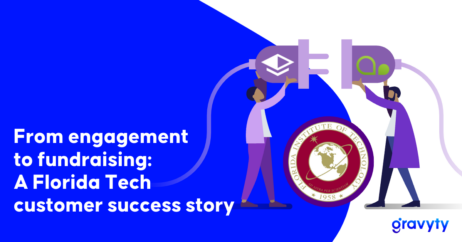How to tackle nonprofit burnout & prevent turnover

In the heart of every nonprofit organization lies a dedicated team of fundraisers tirelessly working to make a difference. Yet, in this noble pursuit, nonprofit leaders face a stark challenge: the nonprofit turnover rate was 19% among fundraising staff in 2023, surpassing the national average of 12%.
Even more concerning is the finding that 46% of fundraising professionals said they plan to leave their current roles within two years. Of that group, almost a quarter (23%) said that nonprofits would not be among the types of organizations they intend to pursue.
But this trend isn’t just about numbers. It represents valued team members’ hopes, efforts, and most importantly, wellbeing. Here, we’ll explore how to address the rising epidemic of turnover and burnout in nonprofit organizations as a real operational challenge and provide tips to mitigate turnover and nurture the wellbeing of fundraising staff and volunteers.
What is nonprofit burnout?
To learn how burnout affects the operations and output of nonprofit organizations, it’s important to understand what burnout means in general. The usage of the term “burnout,” originally coined in the 1970s by an American psychologist, saw a dramatic increase during and shortly following the 2020 pandemic due to frontline workers putting not only their mental health, but also their lives, on the line to get their communities through the depths of COVID.
Now, the term is used widely in our culture to describe the feeling of chronic mental, physical and emotional exhaustion usually related to a job. Burnout is often characterized by feelings of fatigue, overwhelm, and a sense of being emotionally drained. Unsurprisingly, it can affect various aspects of a person’s life, including work, relationships, and overall well-being.
So, how does burnout relate to the nonprofit world? Fundraisers are typically driven by a strong sense of purpose and commitment to the mission and values of the organization they serve. At the same time, increasingly demanding goals paired with a rise in turnover mean they have more on their plates and less time to accomplish it.
Nonprofit burnout & turnover statistics
- 90% of fundraising professionals in a Chronicle of Philanthropy survey on the fundraiser hiring crisis state that unfilled fundraising positions significantly increased their workloads
- 89% of fundraisers agree that their organizations were underemployed to meet their potential for raised funds
- From the same report, 91% of fundraisers say there should be more time to focus on meeting with donors
- 82% of surveyed fundraisers say their roles are underappreciated
- The nonprofit turnover rate was 19% among fundraising staff in 2023
- The average cost to replace a role such as a major gift officer is up 213% of the salary and benefits of the person being replaced
How burnout in nonprofit organizations leads to fundraiser turnover
The connection between fundraiser burnout and turnover is fairly simple (and backed by data): employees that often experience burnout at work are 2.6 times as likely to actively seek other jobs, according to Gallup.
Additionally, 40% of workers leave their job due to burnout. And nonprofit turnover is even more troubling with the statistics referenced above—nonprofit turnover rate was 7% percentage points higher than the national average. Beyond the data points are the less tangible but still critically important aspects of organizational wellbeing: team morale, productivity, and training and onboarding costs to hire new talent.
6 ways to support fundraising staff & mitigate turnover
Recognizing and addressing burnout throughout a nonprofit is key to ensuring a safe, healthy, and productive organization. Here are a few actionable ways to foster wellbeing amongst fundraising staff to reduce burnout and prevent turnover.
Implement comprehensive CRM tracking
In today’s world, donor interactions shouldn’t be a maze of spreadsheets and emails. A robust CRM system reduces the burden of administrative tasks and ensures no crucial information falls through the cracks during staff transitions. A well-integrated CRM makes it easier for frontline fundraisers to focus on what they love (and what works): building meaningful relationships.
Introduce new team members with video
Change can be hard, especially when saying goodbye to a familiar face. When turnover happens and a new gift officer is assigned a portfolio, have a plan in place to make the transition easier.
Make introductions of new gift officers a more seamless, personal experience with video messages. A video allows fundraisers to instill a sense of confidence in the organization during the transition process. Use a tailored video message to relay to the donor how grateful you are for their support now and always.

Streamline work & reduce administrative tasks with CRM integrations
AI-powered fundraising platforms aren’t just about data management; they’re about carving out more time for what matters. By centralizing essential notes and relationship details, fundraisers can alleviate the stress of remembering every little detail, helping teams focus on crafting impactful narratives and connections.
Foster open communication with donors & team members
Transparency is key. In times of transition, ensure your donors and nonprofit team members are part of the conversation. This open dialogue is crucial in building trust and understanding, reminding everyone that they are an integral part of our mission.
Invest in rest: Encourage time off without work distractions
True rest is essential. Encourage fundraisers to take real time off where work emails and calls are put on hold. This isn’t just a break; it’s an investment in mental health and wellbeing, allowing the team to return refreshed and reinvigorated.
Additionally, ensure fundraisers don’t make it a 24/7 job. Donor and volunteer communications and events take place when donors are free, which is often nights and weekends. Encourage your team to find the right work hours and balance.
Commit to continuous training and professional development
A team’s frustration often stems from feeling stagnant or under-skilled. Investing in regular training and professional development is not just about skill-building; it’s a message that we value their growth and see their potential. This commitment can transform morale and increase retention.
And it’s proven: according to CCS, there is a clear correlation between staff investment and revenue. Organizations that invest more in hiring and retention of top fundraising talent see higher revenue growth than those that don’t.
By the end of their first year at the organization, an effective frontline fundraiser will secure enough donations to offset the cost of their salary. And investing in each fundraiser with training and professional development? The ROI will grow exponentially year after year, while the satisfaction with feeling appreciated at their organization will encourage retention.
A fundraiser-first approach to preventing burnout
Beyond these strategies, it’s crucial to recognize the signs of burnout. Are there tasks that consistently drain the fundraising team’s energy? Can you automate any processes to eliminate time spent on manual tasks to focus on more meaningful work? Encourage open discussions about these challenges and explore solutions as an organization. Whether reassigning specific tasks, providing additional training, or simply offering a listening ear, every step taken to address these pain points can reignite the spark in your team.
The success of a nonprofit is more than just hitting targets. It’s about nurturing a community of dedicated people who believe in making a difference. By adopting these empathetic and practical strategies, you can reduce turnover and foster a supportive and fulfilling work environment.




